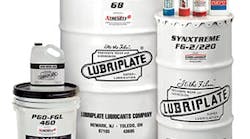The food industry is edging away from “synthetics” in almost every way. But there’s one notable exception.
Food-grade lubricants are broadly divided into two classes: synthetic and mineral oil-based. The situation is roughly analogous to motor oil: Synthetics are more expensive but last longer and can handle a wider range of conditions.
Jim Girard, chief marketing officer for Lubriplate (www.lubriplate.com), says that his company’s food industry customers want long-life food-grade lubricants. Equipment manufacturers “are recommending synthetic fluids and greases, which is the market driver,” he says. New Lubriplate products in this line include polyol ester food grade chain oils and perfluoropolyether (PFPE) greases for extreme high temp applications.
The difference between synthetic and non-synthetic lubricants is mostly in the raw material. “Mineral oil” is a catchall term that denotes a range of products, including lubricants, based purely on crude oil. White mineral oil, used for applications with direct food contact, derives from highly refined petroleum. Synthetic products are based mostly on chemicals other than crude oil, most often esters or olefins, although some synthetic lubricants are blends that include materials derived from crude oil.
“H1” (incidental food contact) food lubricants, like these from Lubriplate, come in many forms, for varying applications.
The biggest single determinant for using synthetic oil is temperature. Synthetics can be engineered to endure both higher and lower temperatures than most mineral-oil-based lubricants.
The highest feasible temperature for an application with a mineral oil lubricant is about 160°F, says David Turner, product specialist at the Clarion Lubricants division of Citgo (www.clarionlubricants.com/FoodGrade). “When you get up around 200°F, it’s time to start thinking synthetic, because the service life of a mineral oil product will be significantly shorter than it would be at a lower temperature,” Turner says.
Matching application temperature to lubricant type is not just a matter of making sure the equipment won’t break down. The lube’s service life should be considered; if it has to be changed too often, any money saved by using it will turn out to be a false economy.
The Clarion Lubricants division of Citgo offers a full line of both mineral-oil-based and synthetic lubricants.
The base temperature for maximum service life tends to be around 175°F for synthetic lubricants, compared with about 140°F for mineral oils, Turner says. As the application temperature rises above 140°F, mineral oils, or any lubricants based on hydrocarbons, tend to break down rapidly. For every 18°F over 140°F, the service life tends to get cut in half. That means a lubricant rated for 1,000 hours of service life at 140°F would have only about 125 hours at 194°F.
On the other hand, end users have a powerful incentive to use mineral oil lubricants: price.
“We recommend the white mineral oil for most food-grade applications simply for economic purposes,” Turner says. He cites a global survey from the National Lubricating Grease Institute that determines that 90 percent of the greases produced around the world are mineral-oil based.
“The vast majority of applications out there, be it gear oils or hydraulic fluids or a few other things, are basically very well covered by mineral oil-based products,” he says. “But there are a few places where a synthetic fluid would be needed.”
Even among synthetics, there are widespread price differences. Much of the product development in synthetic lubricants has to do with finding less expensive alternatives for a given application. For example, Food NH174-401, a new oil from Klüber (https://www.klueber.com/en/), can be used in applications like pulleys and bearings at temperatures up to 450°F. It uses a polyuvea thickening additive with a synthetic base at one-fourth the cost of PFPE grease, according to food marketing manager Marius Czech.
Do you know your H1 from your H2 and why they're important? To learn more about the classifications as well as other terms often used with food-grade lubricants, download this handy guide.
Making the grade
Both mineral-oil-based and synthetic products are subject to certain basic classifications when it comes to use in food plants. Perhaps the most basic is what constitutes being a “food-grade” lubricant in the first place.
Broadly speaking, being classified as food-grade means a lubricant is not toxic if consumed in trace amounts. This is for the most part a matter of starting with a nontoxic base, whether mineral oil or an ester or olefin, and avoiding toxic additives like lead, zinc or lithium.
The entire concept of “food-grade” lubricants doesn’t have long-standing roots. As recently as the late 2000s, a poll of food processors by NSF International showed three out of five did not stock any lubricants rated as suitable for applications with a possibility of food contact.
NSF International is now the primary certification agency for food-grade lubricants, following the U.S. Department of Agriculture’s withdrawal from that role in 1998. NSF’s role in that regard has evolved into what might be called a two-track program.
One track is nonfood compound registration, which is “an independent, third-party review that evaluates proprietary substances and nonfood compounds intended for use in food processing environments,” says Stephanie Ludwig, group leader of nonfood compounds at NSF International. The second applies ISO 21469, a standard for hygiene requirements of lubricants with incidental food product contact promulgated by the International Organization for Standardization.
“While these programs have some similarities, they are separate programs,” Ludwig says.
The nonfood compound registration program is basically a continuation of what the USDA had been doing up to 1998. It involves checking the components of a lubricant, or any other chemical used in a food plant, against a list of compounds that have been found acceptable by the USDA and the FDA for incidental food contact.
“Once the product is deemed acceptable, the product is authorized to bear the NSF Nonfood Compounds Mark with applicable category code and will be listed in the NSF Whitebook,” Ludwig says.
The ISO 21469 program, which NSF launched in 2008, is more rigorous. In addition to the label and formulation review of the nonfood compound registration program, the ISO program includes an onsite audit and product testing.
“The difference between the two programs is that the registration program is a label and formulary review,” Ludwig says. “In addition, the ISO 21469 certification also includes an onsite audit and product testing to ensure the ISO 21469 hygiene standards are being met.”
Unsurprisingly, most lubricant suppliers opt for the older, less rigorous standard. “The majority of our lubricants are registered in the NSF Whitebook under our nonfood compound registration program,” Ludwig says. “We are also seeing an increase of manufacturers seeking the ISO 21469 certification.”
In terms of performance, there isn’t much difference between lubricants certified under the older, USDA-derived NSF standard and those under the newer, more rigorous ISO standard. But because the latter entails on-site inspections and testing by NSF, purity is more assured, which means that the closer a lubricant gets to the actual food or beverage, the more logical ISO-standard products become.
Product proximity
Lubricants are, in fact, classified according to their proximity to product. H1 lubricants are for “incidental food contact” applications, such as conveyors, tank closures, and machinery in close proximity to food. H2 lubricants are used where there is no possibility of food contact.
H2 products are sometimes called “below the line” lubricants, meaning that they can be used on equipment below the conveyor line. They generally are less expensive than H1 lubricants, but lubricant vendors warn that using them that way can be a false economy; if traces of H2 lubricant with a toxic base manage to find their way into product, the result could be serious.
The most stringent rating is 3H, for what are called “release agents.” These are used between product and equipment, for instance to lubricate knife or divider blades or to coat pans for baked goods and other products. Other applications include coating products like apples or eggs directly, for protective and/or aesthetic purposes. Some wineries even use a layer of mineral oil to top off vats of wine, protecting it from oxidation. White mineral oil, which is highly refined, is used most often for these purposes; it’s more economical than vegetable oil.
Paradoxically, a product from Huskey Specialty Lubricants uses vegetable oil as a base for environmental appeal. Biobase HP Lube is positioned as an all-purpose lubricant, for equipment like bearings, chains, pumps and conveyors, that is “the ultimate ‘Green’ lubricant,” according to the company’s website. A similar product, Eco-Lube EP 2, is made with seed oil and is formulated for extreme temperatures, from -20°F to 500°F.
Whether synthetics, mineral-based or vegetable-based, lubricants of every variety are available for food processors for every kind of application. Judicious lubricant selection will balance performance with price without slipping, so to speak, into any pitfalls.


